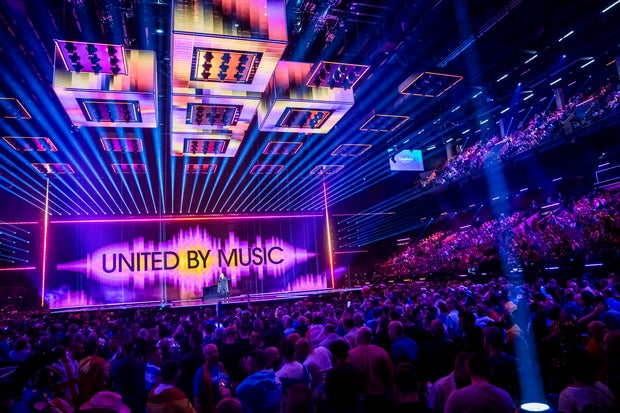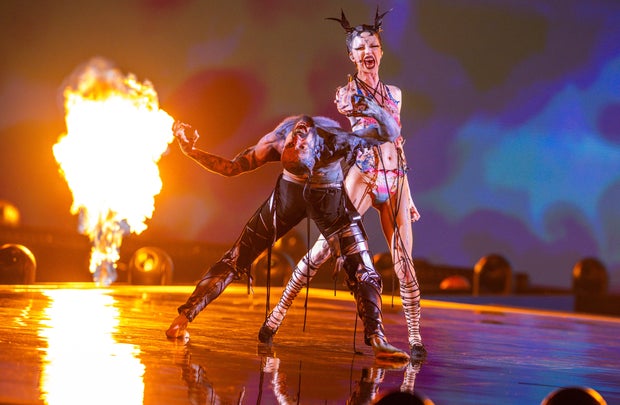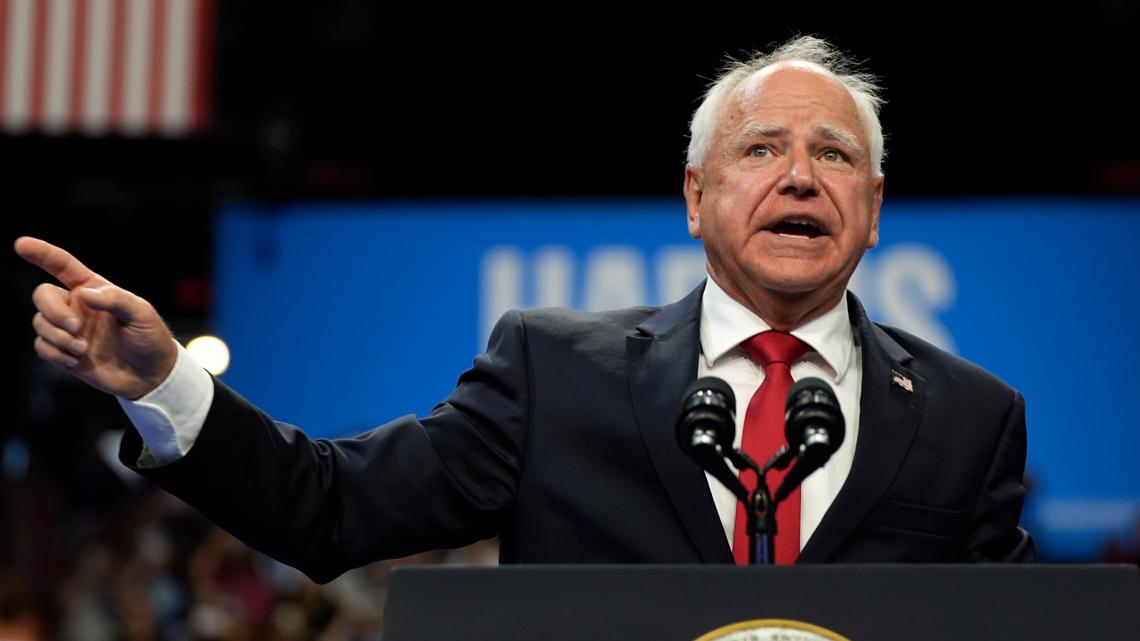CBS News
What is Eurovision? Everything to know about the European song contest

Scores of musicians, hundreds of journalists, and thousands of music fans have gathered in Malmo, Sweden, where the Eurovision Song Contest is building towards Saturday’s exuberant, glitter-drenched final.
But even Eurovision can’t escape the world’s divisions. Thousands of pro-Palestinian protesters are also expected in the city for demonstrations urging a cease-fire in the Israel-Hamas war and criticizing Israel’s participation in the contest.
Here’s a guide to what Eurovision means, how it works, and what to watch for.
What is Eurovision?
The short answer: Eurovision is a music competition, in which performers from countries across Europe, and a few beyond it, compete under their national flags to be crowned continental champion. Think of it as the Olympics of pop music.
The longer answer is that Eurovision is an extravaganza that melds pop, partying and politics — a cross between a music festival, an awards show, and a meeting of the United Nations Security Council. It’s an event full of silly fun, a celebration of music’s unifying power, but also a place where politics and regional rivalries play out.
IDA MARIE ODGAARD/Ritzau Scanpix/AFP via Getty Images
Thirty-seven countries are entered in the contest, which this year is taking place over several days in the Swedish port city of Malmo. The country is hosting after Swedish singer Loreen won last year’s competition in Liverpool, England.
Through two semifinals, the acts have been narrowed to the 25 scheduled to compete in Saturday’s final in front of thousands of spectators in the Malmo Arena and a global television audience estimated at 180 million.
Nations can enter a solo act or a band. They can perform in any genre and language, but the rules state they must sing live and songs must be no more than three minutes long. Staging has grown ever more elaborate, incorporating flashy pyrotechnics and elaborate choreography. This year is particularly strong on topless male dancers.
Once all the acts have performed, the winner is chosen by a famously complex mix of phone and online voters from around the world and rankings by music-industry juries in each of the Eurovision countries. As the results are announced, countries slide up and down the rankings and tensions build. Ending up with “nul points,” or zero, ranks as a national humiliation.
The musical style of Eurovision has diversified dramatically since the contest was founded in 1956. The early years of crooners and ballads gave way to perky pop – epitomized by perhaps the greatest Eurovision song of all time, ABBA’s “Waterloo,” which won the contest 50 years ago.
Nowadays, Euro-techno and power ballads remain popular, but viewers have also shown a taste for rock, folk-rap and eccentric, unclassifiable songs.
Who is expected to win Eurovision?
According to bookmakers, a leading contender is Swiss singer Nemo, who is performing a melodic, operatic song titled “The Code.” Nemo would be the first performer who identifies as nonbinary to win the contest, which has a huge LGBTQ+ following. The contest had its first transgender winner, Dana International, a quarter century ago.
Nemo’s song is performed while balancing on a giant, spinning turntable, but there are no magnets or stage trickery involved, according to the BBC. The singer told the British publication that they are just “balancing all the time” while hitting incredibly high notes.
Jens Büttner/picture alliance via Getty Images
Another nonbinary performer generating huge buzz is Ireland’s Bambie Thug, whose song “Doomsday Blue” was described by the BBC as a “witchy, spooky blend of electro-goth and grinding metal guitars.” They’re the only contestant known to have brought a “scream coach” to Malmo.
“Imagine Kate Bush’s evil twin singing an anti-lullaby and you’ll get the idea,” the BBC said.
Jens Büttner/picture alliance via Getty Images
Other acts tipped to do well include operatic Slovenian singer Raiven, Ukrainian rap-pop duo Alyona Alyona and Jerry Heil and Spain’s Nebulossa, whose song “Zorra” caused a stir because its title can be translated as an anti-female slur.
The act with the most momentum is Croatian singer Baby Lasagna. His song “Rim Tim Tagi Dim” is quintessential Eurovision: exuberant, silly, a little emotional and incredibly catchy. The act is already a huge fan favorite, especially since the singer stepped in as an emergency replacement when another singer pulled out during the contest’s selection process, according to the BBC.
Jens Büttner/picture alliance via Getty Images
What is controversial about Eurovision?
Eurovision’s motto is “united by music,” and its organizer, the European Broadcasting Union, strives to keep politics out of the contest. But it often intrudes.
Belarus was expelled from Eurovision in 2021 over its government’s clampdown on dissent, and Russia was kicked out in 2022 after its full-scale invasion of Ukraine.
This year, there have been calls for Israel to be excluded because of its conduct in its war against Hamas.
Israel is competing but was told to change the title of its song, originally called “October Rain” in an apparent reference to Hamas’ Oct. 7 cross-border attack. It’s now called “Hurricane” and is performed by 20-year-old singer Eden Golan.
Jens Büttner/picture alliance via Getty Images
Thousands of pro-Palestinian demonstrators marched through Malmo hours before Golan performed at Thursday’s semifinal, and another demonstration is planned for Saturday. Swedish police have mounted a major security operation, with officers from across the country bolstered by reinforcements from Denmark and Norway.
One performer initially set to perform in Saturday’s finals has been expelled from the event. The Netherlands’ Joost Klein was among the acts set to perform on Saturday, but the Associated Press said earlier in the day that he was disqualified amid an investigation by organizers over an unspecified “incident.”
The BBC reported that Joost was sent home after “an allegation of intimidation was made to Swedish police by a female member of the production crew.” Dutch officials have called Klein’s disqualification “disproportionate” and said they were “shocked by the decision.”
JESSICA GOW/TT NEWS AGENCY/AFP via Getty Images
Klein cannot be replaced by another act since the disqualification came so late in the process, so Saturday’s finals will proceed with just 25 acts instead of the usual 26, according to the BBC.
CBS News
Behind on your credit card bills this November? 3 options to consider

Getty Images
The holiday season is approaching, but for many Americans, the excitement is being overshadowed by their issues with mounting credit card debt. Right now, the average person owes nearly $8,000 on their credit cards and that’s happening at a time when economic challenges, like inflated housing, groceries and gas costs, are pushing many household budgets to their limits. This perfect storm of elevated credit card balances and budgetary challenges has created a concerning cycle of debt that’s hard to break free from.
What makes the situation particularly challenging, though, is the current state of credit card interest rates. Despite positive shifts in other lending markets, credit card APRs have remained stubbornly high, averaging around 23%. That makes credit card debt one of the most expensive forms of debt, as the compound nature of the interest and the elevated rates mean that any revolving balance you carry becomes increasingly expensive each month.
If you’re finding yourself struggling to meet your credit card obligations this November, you’re not facing this challenge alone. Many cardholders have fallen behind on their bills recently, and while missing payments can trigger serious consequences — from damaged credit scores to compounding late fees — there are several strategies available to help you regain control of your financial situation.
Take steps to get rid of your high-rate credit card debt today.
3 debt relief options to consider this November
If you’re falling behind on your credit card obligations this month, these strategies could help you get back on track.
Find out if you qualify for issuer-based relief
If you’re experiencing temporary financial difficulties, reaching out to your issuer can be a helpful first step. Many card issuers offer hardship programs designed to support customers facing tough economic situations, such as job loss, medical bills or other unexpected expenses. These programs vary by issuer but typically involve temporarily reducing interest rates, waiving fees or establishing a lower monthly payment plan.
For example, some hardship programs may allow you to pause payments for a set period or lower your monthly minimum until you’re in a better financial position. This not only helps avoid late fees and penalties but also prevents your credit score from taking a significant hit. It’s essential to reach out as soon as you anticipate difficulties, though. Waiting until after a missed payment can make it harder to negotiate favorable terms.
Before enrolling in a hardship program, though, make sure you understand the terms and conditions. While such programs can offer short-term relief, they may come with trade-offs, like temporary restrictions on new purchases.
Find out what help a debt relief agency could offer you now.
Utilize one of your debt relief program options
If a hardship program isn’t enough to meet your needs, a debt relief program might offer the help you’re looking for. While there is a wide range of debt relief strategies to utilize, two of the more popular options are debt consolidation programs and debt settlement programs.
With a debt consolidation program, you secure a debt consolidation loan through a debt relief agency’s third-party lending partner to pay off your existing credit card balances. The benefit? You’ll make just one monthly payment at a potentially lower interest rate, which could save you money and simplify your repayment process. Plus, these partner lenders generally have less restrictive borrowing parameters, so borrowing may be easier to qualify for through these programs.
Another option is a debt forgiveness (i.e. debt settlement) program. These programs aim to negotiate with your creditors to reduce the total balance that you owe, often by a significant amount. In many cases, you could see your balance reduced by 30% to 50% or more, making it easier (and cheaper) to pay off what you owe.
Get low-cost guidance from a credit counselor
For those looking to regain control of their finances without taking on more debt or negotiating with creditors, working with a credit counseling agency can be a smart move. Credit counseling agencies offer low-cost or even free advice on budgeting, managing debt and building better financial habits — and can help you devise a plan to manage and reduce your debt.
A popular service offered by credit counseling agencies is a debt management program. With this type of program, the agency works with your creditors to lower your interest rates and create a repayment schedule you can manage. You’ll make one monthly payment to the agency, which then distributes the funds to your creditors. This can streamline the repayment process, reduce interest charges and help you pay off your debt faster than if you were making minimum payments.
The bottom line
Missing a credit card payment can feel overwhelming, but it doesn’t have to derail your financial future. By exploring the options available to you, such as hardship programs, debt relief solutions and credit counseling, you can find a path that fits your financial situation and works toward easing the burden of credit card debt. The most important step is to act early, as addressing the problem before it escalates can prevent additional financial strain and help you regain control of your finances.
CBS News
Here’s how far HELOC interest rates have dropped this year

Getty Images
After more than four years in which interest rates were hiked numerous times, the Federal Reserve started cutting interest rates in September, starting with a larger-than-expected 50 basis point cut. But that was just the beginning, with the Fed continuing to cut rates this week with a 25 basis point reduction. And another cut in the same increment is widely expected when the Fed meets again in December. While these cuts have brought new borrowers into the fold, they underline something that home equity borrowers may have already noticed: Interest rates have been on the decline all year.
This has been particularly noticeable for those who have tapped into their home equity via a home equity line of credit (HELOC). These products have variable interest rates, which can be problematic when interest rates are rising, as they were in 2022 and 2023, but advantageous now that the wider rate climate is cooling again. So how far, precisely, have HELOC interest rates dropped this year? And how much further could they fall? That’s what we’ll break down below.
See how low of a HELOC interest rate you could qualify for here.
Here’s how far HELOC interest rates have dropped this year
HELOC interest rates are traditionally lower than what’s available with credit cards and personal loans, thanks to the home in question serving as critical collateral. But they didn’t start 2024 in a particularly attractive position, coming in at 10.16% on January 3, 2024, according to historical data from Bankrate.
Since that point, however, they’ve dropped significantly, albeit in a bumpy manner. By January 10, 2024, they were averaging 9.32% and by February 7 they were at 9.12%. Rates dropped just below 9% in March but spiked again in May to 9.89% as the battle against inflation appeared more problematic than many had anticipated. As inflation cooled in the following months, however, HELOC rates did, too. They spiked back up to just under 10% in early September but have since dropped significantly with two Fed rate cuts issued.
Now, the average HELOC rate is just 8.70% – almost a point and a half lower than what it was in January. And if inflation continues to drop (the October reading is due out on November 13), HELOC rates will likely continue to fall. And if the Fed issues a final 2024 rate cut in December, as they almost certainly will, rates will likely end the year close to two points lower than where they started it.
That noted, predicting future interest rate changes with precision is almost an impossibility. If you know you need the financing then, and are comfortable with today’s current rates, it makes sense to apply for a HELOC now.
Get started with a HELOC online today.
Why a HELOC may be better than a home equity loan now
Right now, home equity loans actually have a slightly lower rate when compared to HELOCs (8.41% versus the HELOC’s 8.70%). But HELOCs, thanks to that variable interest rate, are better positioned to take advantage of today’s cooling rate environment. Home equity loan rates are fixed, meaning that borrowers will need to refinance them (and pay 1% to 5% of the loan amount in closing costs) to get that lower rate.
Understanding this dynamic, then, and the real potential for rates to continue to decline into 2025, borrowers may want to take a calculated risk by opening a HELOC instead of a home equity loan. It won’t be the right approach for everyone, but if you want to be best positioned to capitalize on what could be multiple rate cuts to come, a HELOC offers you the more optimal way to do so.
The bottom line
HELOC interest rates have plunged by around one and a half percentage points so far this year and many experts predict that they will fall even further in December and into 2025. So, if you want to borrow from your home equity but also want to be able to exploit today’s evolving rate climate, a HELOC may be the preferred option. Just avoid the temptation to overborrow, as well, since your home functions as collateral here and you could jeopardize your ownership if you’re unable to pay back the full line of credit.
Have more HELOC questions? Learn more here now.
CBS News
Iranian operative charged for Trump assassination plot, court records reveal

Watch CBS News
Be the first to know
Get browser notifications for breaking news, live events, and exclusive reporting.
















